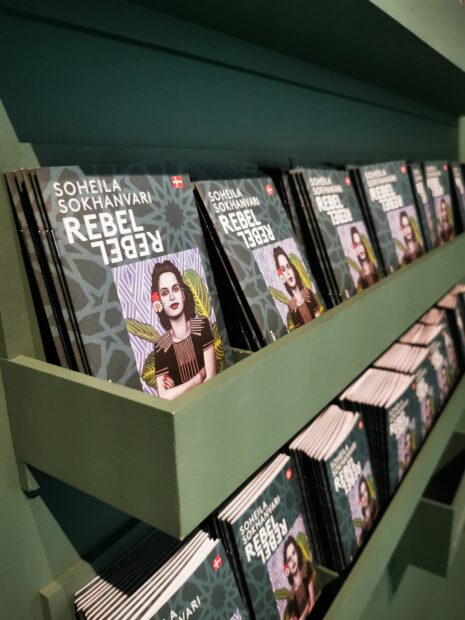More than 20 portraits of iconic female artists, predating Iran’s 1979 Islamic Revolution in Iran, are on display at the museum, in what is the artist’s debut solo exhibition in Denmark.
The collection of miniature paintings sits in a rectangular hall with pine greens walls and floors, covered in Islamic geometrical patterns, a reference to the historical and traditional context where these women hail from.

The whole absorbing atmosphere, coupled with Persian music and lyrics, drags the visitors into the Focus Gallery on ARoS’s Level 5, snatching a good deal of their time spent within the museum.
The soundtrack is a re-mastered compilation of prominent songs by Iranian female vocalists from mid-20th century, a poignant reminder that singing in public remains illegal for women in Iran more than four decades after the revolution.
Covered with mirrors
“The melody lured me in, I returned to the end of the hall to see some of the portraits again and again. I also spent a long time in front of the mirror star, curious to see the visual fragments shown,” says Maha, 24, who is visiting Rebel Rebel a second time.
The giant star installation is covered with mirrors on all sides. The kaleidoscopic canvas functions as a screen reflecting a collage of scenes from the music and cinema of pre-revolution Iran featuring then-famous female stars in scenes of action, love and passion.
The exhibition space reserves the space for some visitors to plunge comfortably for a while in pink cushions encircling the installation and watch the ill-starred bravado of women artists from a bygone era.
Banned females
The 1979 revolution in Iran effectively banned female actresses and singers from working. Some of them were never allowed to appear on the screen again or perform their art in public.
Reeling from the shock of the ban, some of them died in silence and anonymity, although the youngers of them resumed their careers in exile in the years following the revolution.
As I move around in the hall, one middle-aged woman catches my attention in particular. Visibly moved by the atmosphere, she tries to hold back her tears unsuccessfully.
Tempted to ask her why, I regret the decision as she’s already crying.
Perhaps she remembers a golden past for Iranian women as it is referred to, or the continued crackdown on women of Iran serves as a stark contrast in her mind. The level of association and engagement leaves no doubt of her Iranian heritage.
Many Danes have been drawn
But it is not the Iranian community in Denmark that has been frequenting the museum for this exhibition. In fact, as curator Ellen Drude Langevold tells me, Danish people have been equally drawn to the collection.
“Many women and mothers are taking their daughters to see this exhibition and talk about how it is to be a female in different countries,” says Ellen as we sit for a short talk.
“If you have your freedom, you have to use it. You have to appreciate it. So, this was something we really want to investigate in this exhibition and try to lay out for more audience,” Langevold says.

She confirms that the recent women-led protests in Iran have revived public discourse in Denmark surrounding the struggle of women, making Rebel Rebel only more pertinent in the current socio-political climate.
Iran was gripped by public protests for the months after mid-September 2022, when the 22-year-old Kurdish woman Mahsa Jina Amini died in Iran police custody for “not wearing her hijab properly”.
The demonstrations, internationally known by the slogan Woman, Life, Freedom persisted in much of the 2023 and continue to resurge in different forms every now and then.
New era at ARoS
When asked about whether curating a show from a non-Western artist reflects a shift in intuitional policy Ellen confirms that an overhaul in the management of the museum in the past two years has ushered in a new era of representationally at ARoS.
“If you come here in five years, I think the exhibitions and our collection in this place will have a greater representation that we see today”, predicts Ellen Langevold.
The museum holds guided tours of Rebel Rebel for visitors every Sunday evening. Small pamphlets, containing complete information about the portraits in Danish and English are made available at the gallery entrance.
Since the works lack captions, visitors browse through the brochures to learn about the characters.
Out of curiosity, I ask if Ellen is particularly drawn to a character from the collection she curated.
Iran’s most famous soprano
She says it is Monir Vakili that mesmerizes her. Iran’s most famous soprano, Monir Vakili, was a known name due to her stage and TV appearance in Iran’s 1950s & 60s.
She played a pivotal role in the foundation of Tehran’s first opera house, Roudaki, in 1976 before starting to run professional voice training courses out there. She died tragically in a car accident in 1983 while in exile.
Her portrait shines on the cover of the Rebel Rebel pamphlet, a testament to her enduring legacy.
A rebellious spirit
As I bid farewell to Ellen, I embark on one final journey through the collection before its closure on June 2, 2024.
This time, high school students populate the hall, their youthful curiosity piqued by the holographic installations depicting ethereal dances. I sense their resonance with the rebellious spirit that permeates Soheila Sokhanvari’s feminine gallery in Aarhus, Denmark.
*Soheila Sokhanvari (b. 1964) was born in Shiraz, Iran and moved to the UK as a child, a year before the Iranian revolution in 1979. She currently lives and works in Cambridge. Her current show is produced in close collaboration with the artist and Kristin Hjellegjerde Gallery and was originally commissioned by the Barbican, London. (from exhibition pamphlet)















